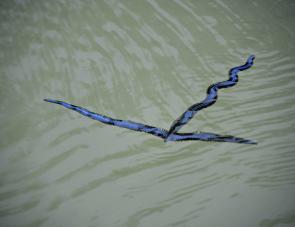What treasures will this year’s wet season divulge in tropical Cape York Peninsula this February? This is a question best answered by the weather gods. For most of us it is a question best pondered from the couch or in the shed as fishing gear is tinkered with in anticipation for drier more moderate conditions.
February is typically the wettest month in Cape York and, depending on localised cyclones and tropical storm activity, it can see anglers completely out of action as rivers rage and squalls ignite the oceans in a lightning-storm fiasco.
For those venturing out of the more substantial population centres of Cooktown, Weipa and Thursday Island, some calm sea conditions during the mornings can produce from fantastic fishing just offshore for queenfish, trevally, tuna and small mackerel. Bait schools will often form just outside the turbid river run-off, which will have a very clear demarcation point this time of year.
Travelling just off the coast from any of the major river systems will bring anglers in touch with pieces of shoaly ground and more often than not flocks of terns and gulls plying the waters for fishy treats. Booby birds will be carving arcs across the wave tops in the Gulf and frigate birds will be flying high above the rest, eagerly awaiting the smaller birds to make a capture so they can soar down and pilfer the spoils.
The barramundi closed season ends February 1 so run-off fishing for the far North’s most iconic species can begin. Although quite different from the run-off fishing known in the Northern Territory, we still have some fantastic options to chase barra supercharged by floodwaters. Rivers up the West Coast of the Cape such as the Mitchell, Archer and Wenlock should by now be pumping freshwater.
Each has a vast network of swamps, lagoons and billabongs which will be overflowing with water and life in February. A multitude of tiny fish, molluscs and crustaceans will be creeping out of these watery domes back into the main river systems to begin life as an adult and the barramundi will be hot on their tails, waiting at ambush points to devour any unlucky little morsels washed out with the floodwaters.
Anglers casting plugs and surface lures should look for colour change and areas where faster water is contrasting with slower moving and back-eddying water. In many of Cape York’s rivers, picking these locations will be easy because clearer run-off water can be seen mixing with the faster paced, dirtier river water.
Just downstream from these spots, look for structure and lines of overhanging trees where the mixed water is being pushed. Cast shallow diving lures just upstream from the structure and twitch them just under the surface as they float past. A hungry barra feeding in the flood run-off will find this very difficult to resist. Using bright colours such as greens, yellows, oranges and pinks will be particularly effective in February.
February is a time for supercharged food and all manner of critters will be moving around in the wetter conditions. Keep your eyes peeled while on the water and be prepared to adapt from your normal techniques to match what you see happening in front of you. If there is a worm hatch or a crab hatch or any type of bait congregation, try and match your offering to suit. Above all when fishing February in Cape York, take the best raincoat money can buy!
Reads: 1457
A couple of recently hatched mangrove worms. These will whet the appetite of the predators.




